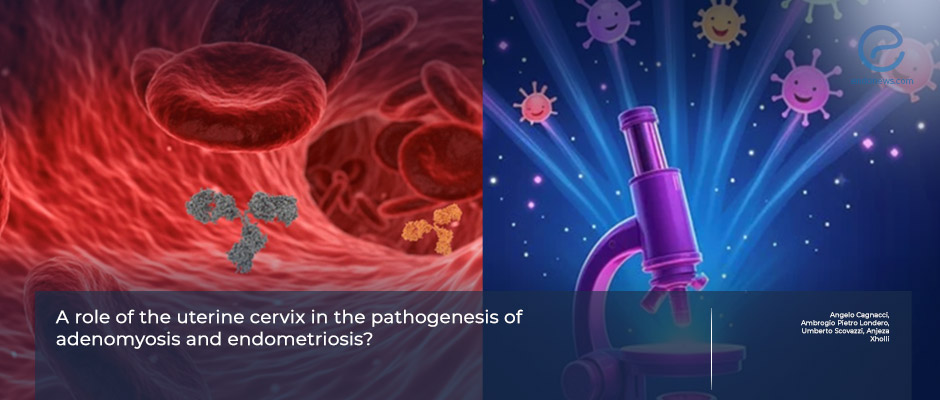Cervix as a Missing Link in Endometriosis Pathogenesis
Aug 7, 2025
Cervical anatomy, stiffness, and angle may shape the risk for adenomyosis and endometriosis through menstrual flow dynamics.
Key Points
Importance:
- Menstrual outflow is influenced by uterine–cervical anatomy, particularly the degree of uterine flexion and the diameter or stiffness of the internal cervical os.
- These factors can alter intrauterine pressure, potentially driving tissue migration into the myometrium resulting in adenomyosis,or peritoneal cavity, resulting in endometriosis.
Highlights:
- Narrowing of the internal cervical os or marked uterine hyperflexion increases intrauterine pressure during menstruation.
- Elevated pressure reduces menstrual outflow, facilitating migration of endometrial tissue into the myometrium (adenomyosis) or retrograde flow into the peritoneal cavity (endometriosis).
What’s Done Here:
- Italian researchers reviewed the evidence linking cervical anatomy and physiology to the pathogenesis of adenomyosis and endometriosis.
- Literature searches in PubMed and Scopus up to 2024 identified the most relevant studies, which were synthesized to summarize current knowledge.
Key Points:
- Dysmenorrhea affects ~25% of women and can be severe when the uterine–cervical flexion angle exceeds 210°.
- Ultrasound-based elastography shows that cervical os stiffness correlates directly with dysmenorrhea severity.
- Increased intrauterine pressure from cervical narrowing or hyperflexion may:
- Force endometrial debris into the myometrium via the endometrial–myometrial junction (potential adenomyosis).
- Propel menstrual tissue into the peritoneal cavity, where—if immune dysregulation, enhanced cell adhesion, or inflammatory cytokines are present—it can seed endometriosis.
From the Editor-in-Chief – EndoNews
"This review shines a spotlight on an often-overlooked structure in gynecologic disease: the uterine cervix. Traditionally regarded as a passive gatekeeper, the cervix emerges here as a dynamic participant in the pathogenesis of both adenomyosis and endometriosis. Its anatomical configuration—particularly the angle of uterine flexion—and the stiffness of the internal cervical os are not merely anatomic curiosities; they can alter menstrual outflow, drive up intrauterine pressure, and set in motion disease-promoting pathways.
By linking cervical mechanics to two distinct but related diseases, this article challenges us to broaden our diagnostic lens. If the cervix indeed modulates the balance between physiological menstrual clearance and retrograde tissue migration, it may represent a novel target for both prevention and therapy. The idea that modifying cervical stiffness or correcting extreme uterine flexion could reduce disease risk is provocative and worth pursuing in future research.
For clinicians, the message is clear: when evaluating patients with severe dysmenorrhea or unexplained pelvic pain, the cervix should not be an afterthought—it may be a critical part of the disease equation."
Lay Summary
The cervix, a 4 cm-long, 2.5–3 cm-wide segment at the lower end of the uterus, plays multiple roles in women’s reproductive health. Lined with mucus rich in antimicrobial peptides, immunoglobulins, immune cells, and exfoliated epithelial cells, it acts as both a barrier and a support structure for pregnancy. Estrogen increases the amount of cervical mucus, decreases its viscosity, and widens mucin pores to facilitate sperm passage, while progestins exert the opposite effect, reinforcing the barrier against bacterial ascent.
Beyond these physiological functions, recent research has linked cervical anatomy and function to the pathogenesis of both adenomyosis and endometriosis. The internal cervical os can obstruct menstrual outflow, and the angle between the uterus and cervix influences menstrual pain severity, when high, indicating severe dysmenorrhea.
During menstruation, strong uterine contractions expel endometrial tissue. However, if the internal cervical os is rigid or the uterine–cervical angle is extreme, these contractions may raise intrauterine pressure. This can damage the endometrial–myometrial junction, allowing endometrial tissue to enter the myometrium (adenomyosis). The same mechanism may also drive endometrial fragments backward through the fallopian tubes into the peritoneal cavity, where they can implant and develop into endometriosis.
This review, published in the International Journal of Gynecology & Obstetrics by Cagnacci and colleagues from Genoa, Italy, synthesizes recent English-language literature to examine how cervical anatomy and physiology might contribute to the development of these two complex gynecologic conditions.
Research Source: https://pubmed.ncbi.nlm.nih.gov/40464061/
adenomyosis dysmenorrhea cervix endometritis infertility pelvic inflammatory disease pathogenesis endometriosis.

